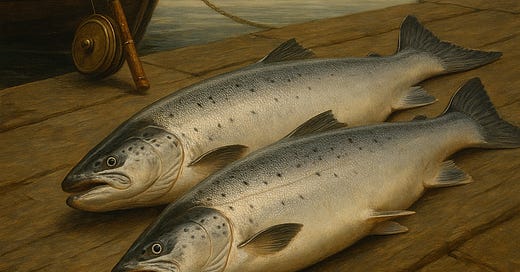Model Portfolio Action
Action: Long MOWI ASA and SalMar ASA (1% each)
Stop-Loss: −20%
Catalyst Timing: H2 2025 volume ramp, Q3/Q4 margin expansion, Mowi’s Nova Sea consolidation, SalMar’s offshore scale-up
Bonus: We’re also initiating a tactical SPY put position, because, quite literally, something smells fishy. Elevated equity valuations and rising geopolitical noise suggest portfolio-level convexity is warranted as we lean into idiosyncratic alpha. Instrument: SPY US 08/15/25 P540 Equity (1%)
Executive Summary
The salmon trade is back, but the market hasn’t caught the scent yet.
We initiate buys for MOWI and SalMar, the #1 and #2 global salmon producers, based on clear visibility into harvest growth, margin normalization, and capital return. After absorbing the impacts of a resource tax, weak fish biology, and overhangs from 2023 supply shocks, both companies are entering an operational upcycle. But market valuations still reflect cyclical lows.
What the market is missing: volumes are ramping, cost/kilo is falling, and neither company needs higher spot prices to drive earnings growth. Spot prices were soft in Q1, but both Mowi and SalMar reported stable realized pricing and better-than-expected fish health. As higher harvest weights convert into sales through Q3/Q4, margin leverage should accelerate.
Mowi’s global integration and scale allow it to profitably arbitrage geography. SalMar’s focused execution and offshore advantage give it a cost base that rivals can’t match. These are not commodity producers, they’re industrial-grade precision operators.
Why This Setup Matters
Volumes Are the Earnings Flywheel
Mowi delivered 108k tonnes in Q1 2025, +12% YoY, setting a record. Volumes matter because every additional kilo spreads fixed costs over a larger base. Management explicitly expects more scale-driven cost leverage into H2.
SalMar’s 2025 Norway harvest guide is +14% YoY, and biomass in sea is up YoY. This means H2 volumes will be even stronger, as smolt turn into harvests.
Remember: higher volumes = lower cost/kg = margin expansion.
Margins Have a Clear Path Higher
Mowi’s Q1 cost/kg was €5.89, down YoY. SalMar’s Q1 cost/kg was flat QoQ, but materially better than H1 2024. As larger fish grow faster in warmer water, feed efficiency improves. This isn’t theoretical, the Q1 margin beat was real, driven by biology.
Unlike other agri stocks, these margins are not weather-dependent: both firms invest heavily in post-smolt and feed conversion optimization, improving biology year over year.
Stable Pricing Amid Surging Supply
Global supply rose +8% in Q1 2025. Yet both firms held realized pricing flat YoY. Why? Global salmon demand remains inelastic at mid-80s NOK/kg, and Mowi/SalMar secure 25%+ of volumes on contract. They’re not price takers. They’re price setters with strategic offtake.
Moreover, Mowi’s downstream Consumer Products arm expands EBIT in low-price environments, acting as a natural hedge. Q1 CP EBIT: €33M, up +38% YoY.
Capex Is Creating Operating Leverage, Not Burn
Mowi is scaling to 600kt by 2026 with Nova Sea, up from 464kt in 2024. But it’s doing so off existing licenses and post-smolt upgrades, not new greenfield builds. ROIC should rise.
SalMar’s offshore units are already growing fish. Management is executing phase-gated expansion, and recent refinancing through green bonds (NIBOR+1.15%) locks in cheap capital.
Capital Return Is Active, Not Aspirational
Mowi pays NOK 1.70/share quarterly (~3.5% yield) and has room to grow with FCF. SalMar pays NOK 22/share annually (~5% yield) and is distributing 98% of 2024 EPS.
Key Risks
Fish Health: However, Q1 marked a turnaround in fish health. The companies have real-time control loops: cleaner fish, vaccine updates, offshore fallback.
Spot prices: Q1 spot prices were soft, but downstream units expanded EBIT. 25%+ of volume is pre-committed, and both firms operate profitably at mid-70s NOK/kg.
Regulation: Norway’s resource tax is now absorbed in models. If anything, it creates consolidation tailwinds. Tariffs? Yes, the US imposed them. But salmon is fungible. Volumes shift, pricing equilibrates.
Bottom Line
This is a re-rating setup. The biology shock is fading. Volumes are accelerating. Operating leverage is kicking in. Capital is being returned. Yet valuations still anchor to the downcycle.
SalMar and Mowi are not “just” salmon stocks. They are global agritech operators with real cost advantages, disciplined growth plans, and downside protection built into the model. With volumes, margins, and capital return all trending positively, the market will smell what’s cooking soon enough.
Disclaimer:
Ridire Research is an independent content and research publication affiliated with Ridire Capital Management, a private investment adviser. The materials published herein, including explicit labels such as “Buy,” “Sell,” “Hold,” “Long,” or “Short”, are for general informational and educational purposes only. These views represent the author’s opinion based on publicly available information, internal research frameworks, and market analysis at the time of writing. They are not tailored to the specific investment objectives, financial situation, or risk tolerance of any individual investor.
Ridire Capital Management, its affiliates, and/or employees may hold, trade, or modify positions, long or short, in the securities mentioned, with no obligation to update disclosures or inform readers of changes. Any trade or allocation referenced should be viewed strictly in the context of a model portfolio and not as a solicitation or offer to buy or sell any security.
While all efforts are made to ensure factual accuracy and analytical rigor, no representation or warranty is made regarding the completeness, accuracy, or reliability of the information provided. Readers are urged to perform their own due diligence or consult with a licensed financial advisor before making any investment decisions. Past performance is not indicative of future results. Investing involves risk, including the risk of loss.




